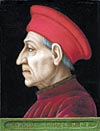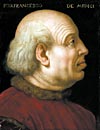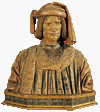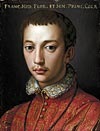The Medici have been ideally brought back to their
Mugello villas of Trebbio, Cafaggiolo and Pratolino
(thanks to their evocation in the portraits and to the
lunettes depicting these dwellings), the places where
they spent so many serene moments: Cosimo the Elder,
his nephew Pierfrancesco (his brother Lorenzo’s son),
his grandson Lorenzo (Piero the Gouty’s son) and in the
end, jumping another three generations, Francesco (the
other Cosimo’s son), the grand duke in love with the
beautiful Venetian Bianca Cappello.
 Cosimo (1389-1464), the
first-born son of Giovanni di Bicci (1360-1429) and
Piccarda Bueri (1368-1433), demanded to be buried in
the tomb set at the center of the cross vault pillar of
the church of San Lorenzo, where there were the
masterpieces of his brotherly friend Donatello that he
himself had commissioned, near the palace that he had
had built by the faithful architect Michelozzo, in
which he had gathered gems, sculptures, paintings and
manuscripts. The political message of this choice for
his own burial was very clear: he was by then the lord
of Florence so much as to deserve, after his death, the
appellative of Pater Patriae by decree of the
Seigniory. He had acquired the political supremacy over
the city, even remaining a private citizen, thanks to
the control of the public appointments within the
Republican institutions and to a well-established
economic fortune that allowed him, for example, to host
in 1439 the council destined to re-unite the Eastern
church with the Western one.
Cosimo (1389-1464), the
first-born son of Giovanni di Bicci (1360-1429) and
Piccarda Bueri (1368-1433), demanded to be buried in
the tomb set at the center of the cross vault pillar of
the church of San Lorenzo, where there were the
masterpieces of his brotherly friend Donatello that he
himself had commissioned, near the palace that he had
had built by the faithful architect Michelozzo, in
which he had gathered gems, sculptures, paintings and
manuscripts. The political message of this choice for
his own burial was very clear: he was by then the lord
of Florence so much as to deserve, after his death, the
appellative of Pater Patriae by decree of the
Seigniory. He had acquired the political supremacy over
the city, even remaining a private citizen, thanks to
the control of the public appointments within the
Republican institutions and to a well-established
economic fortune that allowed him, for example, to host
in 1439 the council destined to re-unite the Eastern
church with the Western one.
 His nephew Piefrancesco
(1430-1476), on the other hand, nourished interest
neither in politics (even having carried out some
public appointments) nor in art; he much preferred to
live the country life in the villa of Trebbio, that had
been assigned to him by his uncle, where he cultivated
his passion for dogs and horses.
His nephew Piefrancesco
(1430-1476), on the other hand, nourished interest
neither in politics (even having carried out some
public appointments) nor in art; he much preferred to
live the country life in the villa of Trebbio, that had
been assigned to him by his uncle, where he cultivated
his passion for dogs and horses.
 Barely twenty years old when he took the reins of
power of the oligarchic Florentine Republic government,
after his grandfather Cosimo and the premature death of
his father Piero (1416-1469), Lorenzo
(1449-1492), later known as the Magnificent, soon
encountered the hostility of the great Florentine
families, that presumed they could easily free
themselves from the Medici yoke given the young age of
the new ‘lord’ of the city. This opposition culminated
in the 1478 Pazzi Conspiracy that cost the life of his
younger brother Giuliano (1453-1478). However, Lorenzo
was able to hold power and, with skillful diplomatic
moves, he succeeded in having the war with the pope
called off and in reaching a peace accord in the end,
thus beginning his adroit policy of balance and
alliances among the various Italian states. It was a
brief but luminous period in which the arts and culture
flourished: the poet Agnolo Poliziano, the neo-platonic
philosopher Marsilio Ficino, and the artists Giuliano
da Sangallo, Verrocchio and Botticelli were among those
who frequented the court of the Magnificent until his
early death in 1492.
Barely twenty years old when he took the reins of
power of the oligarchic Florentine Republic government,
after his grandfather Cosimo and the premature death of
his father Piero (1416-1469), Lorenzo
(1449-1492), later known as the Magnificent, soon
encountered the hostility of the great Florentine
families, that presumed they could easily free
themselves from the Medici yoke given the young age of
the new ‘lord’ of the city. This opposition culminated
in the 1478 Pazzi Conspiracy that cost the life of his
younger brother Giuliano (1453-1478). However, Lorenzo
was able to hold power and, with skillful diplomatic
moves, he succeeded in having the war with the pope
called off and in reaching a peace accord in the end,
thus beginning his adroit policy of balance and
alliances among the various Italian states. It was a
brief but luminous period in which the arts and culture
flourished: the poet Agnolo Poliziano, the neo-platonic
philosopher Marsilio Ficino, and the artists Giuliano
da Sangallo, Verrocchio and Botticelli were among those
who frequented the court of the Magnificent until his
early death in 1492.
 Francesco (1541-1587) found
himself moving in a quite different political and
cultural scenario; his father, the ambitious and
pragmatic Cosimo (1519-1574) had conferred on him the
title of regent in 1564, making him marry the following
year Johanna of Austria (1547-1578), the daughter and
sister of emperors. He was destined to become grand
duke of Tuscany, the second Medici after Cosimo had
obtained the coveted title. More than the games of
power, however, the new prince loved to take part in
scientific experiments in the grand ducal workshops,
retreating into his very refined Studiolo, in the
Medici quarters of the Signoria Palace, where he kept
inside cupboards closed with doors painted by the most
fashionable Mannerist painters, extremely precious
natural and artificial objects, or, ultimately,
spending time with the beautiful and much beloved
Bianca Cappello (1548-1587). Thus, when he became grand
duke of Tuscany in 1574 upon his father’s death, he
continued to cultivate these interests, marrying the
Venetian gentlewoman after the death of his wife,
Johanna of Austria, increasingly indifferent to the
affairs of state and often far from the city to stay
instead in his splendid villas.
Francesco (1541-1587) found
himself moving in a quite different political and
cultural scenario; his father, the ambitious and
pragmatic Cosimo (1519-1574) had conferred on him the
title of regent in 1564, making him marry the following
year Johanna of Austria (1547-1578), the daughter and
sister of emperors. He was destined to become grand
duke of Tuscany, the second Medici after Cosimo had
obtained the coveted title. More than the games of
power, however, the new prince loved to take part in
scientific experiments in the grand ducal workshops,
retreating into his very refined Studiolo, in the
Medici quarters of the Signoria Palace, where he kept
inside cupboards closed with doors painted by the most
fashionable Mannerist painters, extremely precious
natural and artificial objects, or, ultimately,
spending time with the beautiful and much beloved
Bianca Cappello (1548-1587). Thus, when he became grand
duke of Tuscany in 1574 upon his father’s death, he
continued to cultivate these interests, marrying the
Venetian gentlewoman after the death of his wife,
Johanna of Austria, increasingly indifferent to the
affairs of state and often far from the city to stay
instead in his splendid villas.



